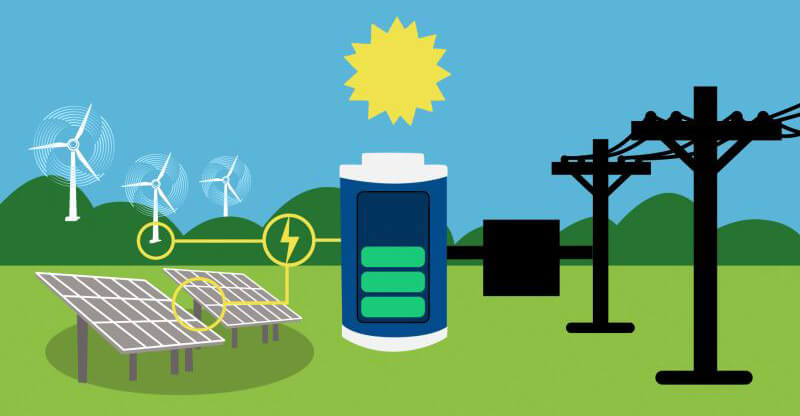Introduction
If you’re looking for a reliable, maintenance-free energy solution for electric vehicles or backup power systems, you’ve probably encountered the name AGM battery. But what is AGM battery technology, and why is it such a popular option in the modern world of available energy systems? This article will cover what AGM (absorbed glass mat) technology is, including some information on how AGM batteries work, their benefits, the best techniques for charging them, and how they compare with other batteries. Whether you’re working with an off-grid solar system, or electric vehicles, this article from the staff of renewable energy supply company SINEXCEL-RE has the information you will want to know.
What Does AGM Mean?
AGM refers to Absorbed Glass Mat, a design innovation developed for Valve-Regulated Lead Acids (VRLA). In contrast to conventional flooded batteries where liquid electrolyte is free to move, the AGM employs fine glass matt which absorbs and immobilises the electrolyte between the lead plates. This results in a sealed, spill-proof battery which affords better performance and charging characteristics with an increased longevity. AGM batteries are now used in automotive, solar, UPS, marine and telecommunications fields where reliability and maintenance-free operation is a prime requisite.
How an AGM Battery Works
Glass Mat Separator: A fine glass mat separator is placed between the positive and negative plates. The mat absorbs electrolyte like a sponge.
Immobility of the Electrolyte: The acid is uniformly present in the glass mat. Chemical action is thus capable of taking place, and leaks are avoided.
Pressure Regulated Valve: All AGM batteries are sealed and valve regulated. This system prevents escape of gases and makes them maintainance free, since internal pressure is retained.
Recombination of Oxygen: When the battery is being charged oxygen produced in the positive plate is combined with hydrogen in the negative plate to form water again. This recovers the electrolyte and increases life of the battery.
Figure 1 shows what the differences are between AGM batteries and standard flooded types. The electrolyte being absorbed into the glass mat has produced contact between the active materials close enough so as to gain better power output, better vibration resistance and no leakage.
Figure 1. AGM Battery Internal Design Diagram
Key Advantages of AGM Batteries
The absorbed glass mat battery design provides multiple performance and safety benefits over traditional lead-acid batteries. Here’s why many industries are switching to AGM shown in Table 1.
Table 1. Key Advantages of AGM Battery Technology
| Feature | Advantage |
| Maintenance-Free | No need to add water or check acid levels. |
| Spill-Proof Design | Sealed structure prevents leaks and corrosion. |
| High Power Output | Delivers strong bursts of current for vehicles and inverters. |
| Fast Charging | Low internal resistance allows rapid charging efficiency. |
| Vibration & Shock Resistant | Perfect for off-road, marine, and industrial equipment. |
| Longer Lifespan | Typically lasts longer than flooded lead-acid batteries. |
| Low Self-Discharge | Retains charge longer during storage. |
| Flexible Mounting | Can be installed in multiple orientations (except upside down). |
AGM Battery Applications
Table 2. Common Applications of AGM Batteries
| Application Area | Description | Key Benefits |
| Automotive and Start-Stop Vehicles | AGM batteries are widely used in modern cars with start-stop systems that require rapid power bursts and frequent cycling. | High cranking power, quick recharge, maintenance-free, long lifespan. |
| Solar and Renewable Energy Systems | Deep-cycle AGM batteries store solar energy efficiently and provide consistent power output during low sunlight or nighttime.Check our High-Volt Storage Battery Cluster Test System for performance evaluation and optimization. | Reliable energy storage, deep discharge capability, spill-proof, safe operation. |
| Uninterruptible Power Supply (UPS) | Used in backup systems for data centers, hospitals, and telecommunication networks. | Instant power delivery, long standby life, maintenance-free design. |
| Marine and Recreational Vehicles (RVs) | Ideal for boats, yachts, and RVs where vibration resistance and sealed construction are vital. | Shock-resistant, corrosion-free, flexible installation, safe in confined spaces. |
| Industrial and Backup Power Systems | Powering forklifts, emergency lights, and remote control systems where downtime isn’t acceptable. | Reliable under heavy load, durable, low self-discharge. |
| Telecom and Off-Grid Infrastructure | Used in remote cell towers and base stations to maintain uptime during grid outages. | Consistent energy supply, low maintenance, high reliability in extreme conditions. |
Figure 2 shows that AGM batteries can be used with solar photovoltaic systems.
Figure 2. AGM Battery in Solar Energy Storage
AGM Battery Charging: Best Practices
Appropriate AGM battery charging is the key to extending the lifespan and performance of your AGM deep-cycle battery. A high-quality smart charger or AGM specific charger is recommended. As it provides a stable charging voltage and effectively prevents overcharging. A 12V AGM battery provided better performance when it charged in between 14.4V to 14.8V during the absorption or bulk phase and maintained between 13.5V and 13.8V during the float or maintenance phase. Equalization charging is not necessary in sealed AGM batteries. Always check the manufacturer’s datasheet, to confirm the voltage range exactly.
Safety must be the first consideration, when it comes to charging. Use a temperature compensated charger to avoid overheat and internal glass mat injury. Overcharging should be avoided because high voltage can cause the separator to dry out. Recharge the battery before long-term storage is also important to prevent sulfation and maintain full capacity.
AGM vs. Other Battery Types
There are numerous lead-acid battery technologies on the market today. AGM batteries also one of them. AGMs provide the ideal balance of power, safety, and low maintenance. when it compared to flooded lead-acid and gel batteries. AGM batteries are totally sealed and require no maintenance. In contrast to flooded batteries that have free-flowing acid and need to be regularly topped off with distilled water. Although gel batteries have a slower rate of charge and discharge. they also have a sealed design.
Lithium batteries have a higher energy density. it can charge more quickly, but they are more costly and need a sophisticated Battery Management System (BMS) to operate safely. Because of their exceptional reliability, cost, and performance balance, AGM batteries continue to be the most sensible and economical option for the majority of users in automotive, UPS, and renewable energy systems.
Deep-Cycle AGM Batteries
Deep-cycle AGM batteries are designed, for long and steady energy discharge over time. making them ideal for off-grid and renewable energy setups. Deep-cycle AGMs can provide steady power for hours without sustaining damage, in contrast to starter batteries, which only provide brief spikes in current. These batteries are frequently found in telecom towers, solar energy systems, RVs, and marine applications.
They are a popular option for energy storage due to their safety, reliability, and lack of maintenance. AGM deep-cycle batteries are still preferred in many installations due to their affordability, recyclability, and demonstrated performance in a range of scenarios, even though lithium batteries are becoming more and more well-liked due to their higher energy density.
AGM Batteries for Cars
Electrical systems in modern cars are highly dependent on reliable, potent energy delivery. These needs are satisfied by AGM automobile batteries. which is outperform traditional flooded batteries in terms of cranking power, vibration resistance, and recharge times. They work particularly well with start-stop systems. which use automatic engine shutdown and restart to save fuel.
AGM batteries are also well-suited for vehicles operating in extreme conditions, as they maintain performance in both cold and hot temperatures. Their long service life and sealed design provide peace of mind, by removing the need for maintenance. When “AGM” is printed on a car battery, it indicates that it uses Absorbed Glass Mat technology, which is designed to be dependable, efficient, and long-lasting in harsh automotive settings.
Maintenance and Longevity
AGM batteries are thought to require no maintenance. Their lifespan can be greatly extended with the right care. Incompatible devices can reduce battery life, always use the appropriate charger type. Unless the battery is made especially for deep-cycle applications. do not fully discharge it. To avoid internal plate damage, keep the battery at a nominal temperature. It should also clean the terminals from time to time to avoid corrosion accumulation. Make sure the battery is completely charged after prolonged use, to preserve its capacity and avoid sulfation.
High-quality AGM batteries can last up to eight years or more. if can take properly cared. For anyone looking for long-term, reliable power storage, they are a wise investment due to their low maintenance design and durability.
Conclusion
The AGM battery most reliable and adaptable energy storage options on the market right now. It bridges the gap between conventional lead-acid and cutting-edge lithium-ion systems by providing the ideal balance of safety, performance, and affordability.
AGM batteries from SINEXCEL-RE Renewable Energy offer the reliability and efficiency your energy projects require, Whether you are operating a solar-integrated charging station, overseeing a marine vessel, or keeping up an industrial backup system. These batteries will continue to provide steady and reliable power for many years to come if they are properly maintained.
FAQ
What does AGM mean on a battery?
It stands for Absorbed Glass Mat, referring to the fiberglass separator that absorbs and immobilizes the electrolyte, preventing leaks.
How does an AGM battery work?
It uses glass mat separators between lead plates to hold the electrolyte and maintain close contact for efficient charge/discharge reactions.
Can AGM batteries be used as deep-cycle batteries?
Yes — AGM deep-cycle batteries are designed for continuous energy discharge, perfect for solar and off-grid use.
What voltage should I charge an AGM battery at?
For 12V AGMs:
- Bulk Charge: 4–14.8V
- Float Charge: 5–13.8V
Are AGM batteries better than standard lead-acid?
Yes — AGMs are more efficient, safer, and longer-lasting than flooded lead-acid batteries.
How long do AGM batteries last?
4–8 years, depending on use, temperature, and charging practices.




